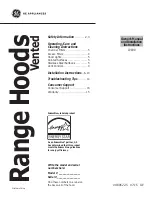
6
49-80622-5
BEFORE YOU BEGIN
Read these instructions completely and carefully.
•
IMPORTANT –
Save these instructions for local
inspector’s use.
•
IMPORTANT –
Observe all governing codes and
ordinances.
•
Note to Installer –
Be sure to leave these instructions
with the Consumer.
•
Note to Consumer –
Keep these instructions for future
reference.
• Skill level – Installation of this appliance requires basic
mechanical and electrical skills.
• Completion time – 1–3 hours
• Proper installation is the responsibility of the installer.
• Product failure due to improper installation is not covered
under the Warranty.
* IMPORTANT: If a rectangular-to-round
transition adaptor is used, the bottom
corners of the damper will have to be
cut to fit, using the tin snips, in order to
allow free movement of the damper.
DUCTWORK REQUIREMENTS
WARNING –
Before beginning the
installation, switch power off at service panel and lock the
service disconnecting means to prevent power from being
switched on accidentally. When the service disconnecting
means cannot be locked, securely fasten a prominent
warning device, such as a tag, to the service panel.
FOR YOUR SAFETY:
Questions?
Call
800.GE.CARES (800.432.2737)
or Visit our Website at:
GEAppliances.com
Installation Range
Hood
Instructions
WARNING –
TO REDUCE THE RISK OF FIRE,
USE ONLY METAL DUCTWORK.
NOTE: Read the ductwork sections only if you do not have
existing ductwork. If you have existing ductwork, skip to
the “Damage” section and proceed.
The venting system must exhaust to the outside.
This hood can be vented vertically through upper cabinets
or horizontally through an outside wall. Ductwork is not
included.
Exhaust connection:
The hood exhaust has been designed to mate with
standard 3
1
ø
4
” x 10” rectangular ducting.
If a 7” round duct is required, a rectangular-to-round
transition adaptor must be used*. Do not use less than a
7” diameter duct.
Duct length:
The ducting from this fan to the outside of the building has
a strong effect on the air flow, noise and energy use of the
fan. Use the shortest, straightest duct routing possible for
best performance, and avoid installing the fan with smaller
ducts than recommended. Insulation around the ducts can
reduce energy loss and inhibit mold growth. Fans installed
with existing ducts may not achieve their rated air flow.
WARNING –
TO REDUCE THE RISK
OF FIRE, ELECTRIC SHOCK OR INJURY TO PERSONS,
OBSERVE THE FOLLOWING:
A. Installation work and electrical wiring must be done by
qualified person(s) in accordance with all applicable codes and
standards, including fire-rated construction.
B. Sufficient air is needed for proper combustion and exhausting
of gases through the flue (chimney) of fuel burning equipment
to prevent back drafting. Follow the heating equipment
manufacturer’s guideline and safety standards such as
those published by the National Fire Protection Association
(NFPA), the American Society for Heating, Refrigeration and Air
Conditioning Engineers (ASHRAE) and the local code authorities.
When applicable, install any makeup (replacement) air system
in accordance with local building code requirements. Visit
GEAppliances.com for available makeup air solutions.
C. When cutting or drilling into wall or ceiling, do not damage
electrical wiring and other hidden utilities.
D. Ducted fans must always be vented to the outdoors.
WARNING –
TO REDUCE THE RISK OF FIRE AND
723523(5/<(;+$867$,5%(685(72'8&7$,52876,'(³
DO NOT VENT EXHAUST AIR INTO SPACES WITHIN WALLS OR
CEILINGS OR INTO ATTICS, CRAWL SPACES OR GARAGES.
Содержание JVE40
Страница 30: ...14 49 80622 5 Notes ...







































